TABLE OF CONTENTS
- PREPARATION OF HYBRID GEL AND BIOMATERIAL APPLICATION BY NANOGEL ENGINEERING
- STRESS MEASURING METHOD FOR MICROTOME, AND STRESS MEASURING INSTRUMENT FOR MICROTOME
- PLATE FOR RECOVERING BIOMATERIAL
- NUCLEIC ACID ISOLATION MEMBER AND METHOD FOR PRODUCING THE SAME
- SILANE COUPLING AGENT
- NEW POLYPEPTIDE AND METHOD FOR PRODUCING THE SAME
- MATERIAL MACHINING METHOD BY MULTI-WAVELENGTH ULTRASHORT PULSE LASER BEAM
- PRETREATMENT METHOD AND APPLICATION OF BIOMATERIAL
- IMPROVED METHOD IN EXTRACTION AND PURIFICATION OF PROTEIN FROM BIOMATERIAL
- BIOMATERIAL FOR ARTIFICIAL CARTILAGE
- METHOD FOR EXTRACTING RNA, AND METHOD FOR ANALYZING BIOMATERIAL
- BIOMATERIAL
- BIOMATERIAL AND ITS MANUFACTURING METHOD THEREOF
- CERAMIC SINTERED COMPACT, METHOD FOR PRODUCING THE SAME, AND BIOMATERIAL
- COMPOSITE OSTEOSYNTHESIS MATERIAL
- POROUS STRUCTURE
- ARTIFICIAL BIOMATERIAL AND ITS PRODUCTION METHOD
PREPARATION OF HYBRID GEL AND BIOMATERIAL APPLICATION BY NANOGEL ENGINEERING
| (11)Publication number : | 2005-298644 |
| (43)Date of publication of application : | 27.10.2005 |
| (51)Int.CI. C08F290/10 A61K 9/127 A61K 38/28 A61K 47/36 A61K 47/48 A61P 3/10 A61P 5/50 B01J 13/00 B82B 3/00 |
| (21)Application number : | 2004-115613 | (71)Applicant : | AKIYOSHI KAZUNARI |
| (22)Date of filing : | 09.04.2004 | (72)Inventor : | AKIYOSHI KAZUNARI MORIMOTO NOBUYUKI IWASAKI YASUHIKO |
| Abstract: PROBLEM TO BE SOLVED: To achieve synthesis and utilization of a new hybrid gel (nanogel engineering) in which the structure is controlled by using a self-organized nanogel as a building block. SOLUTION: The main features of this invention are the synthesis of a polymerizable self-organized nanogel (nanogelomer), the synthesis of a new hybrid nanogel, the synthesis of a hierarchical gel using the nanogel as a crosslinking point, functions as a physiologically active substance reservoir system and the synthesis of a liposome network gel using a nanogel-liposome composite as the crosslinking point. |
STRESS MEASURING METHOD FOR MICROTOME, AND STRESS MEASURING INSTRUMENT FOR MICROTOME
| (11)Publication number : | 2005-265788 |
| (43)Date of publication of application : | 29.09.2005 |
| (51)Int.CI. | G01N 1/06 |
| (21)Application number : | 2004-082749 | (71)Applicant : | IKEGAMI SEIKI:KK |
| (22)Date of filing : | 22.03.2004 | (72)Inventor : | KINDO ZENICHIRO ASAKURA KENTARO TANIYAMA AKIRA KINDO JIRO SATO IKUTOMO SAITO MAKOTO MORIWAKI TORU HIROHATA YASUHISA NIWA HIROTSUGU NAKAMURA SHINICHI HOSHINO YOSHINORI |
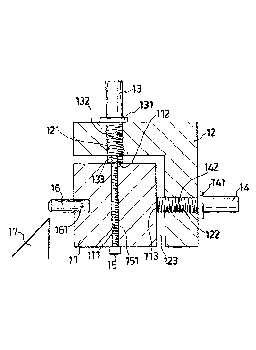 Abstract: Abstract:PROBLEM TO BE SOLVED: To provide a stress measuring method for a microtome and a stress measuring instrument for the microtome capable of evaluating mechanical strength, adhesion strength, a surface property and the like of a biomaterial, an industrial material, a laminate thereof, an inter-different-substance interface, a fine particle, an anisotropic sample, an ultrathin film or the like. SOLUTION: Vertical-directional cutting force generated when cutting a sample along a vertical direction, and horizontal-directional force right-angled to the cutting force are detected respectively by a stress conversion means to find by computation a characteristic value of the sample, for example, a friction coefficient applied on the sample, an average vertical stress on a shearing face and average shearing force, together with a cutting width, a set thickness and the like. |
PLATE FOR RECOVERING BIOMATERIAL
| (11)Publication number : | 2005-261365 |
| (43)Date of publication of application : | 29.09.2005 |
| (51)Int.CI. |
C12M 3/00 C12M 1/00 C12N 5/06 |
| (21)Application number : | 2004-081577 | (71)Applicant : | IWAMOTO YUKIE NAKAYAMA KOICHI |
| (22)Date of filing : | 19.03.2004 | (72)Inventor : | IWAMOTO YUKIE TANAKA KAZUHIRO MATSUDA SHUICHI NAKAYAMA KOICHI |
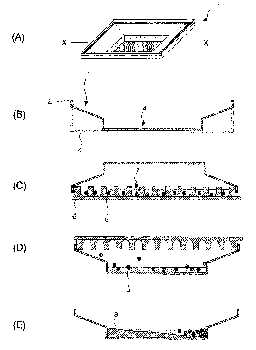 Abstract: Abstract:PROBLEM TO BE SOLVED: To provide a method for readily recovering a cultured biomaterial at a low cost. SOLUTION: The subject plate for recovering the biomaterial has a concave part capable of recovering the biomaterial when the plate is attached to a culture container of the biomaterial and reversed. The method for recovering the biomaterial comprises attaching the plate to the container in which the biomaterial is cultured, reversing the plate and subjecting the plate to centrifugal separation. |
NUCLEIC ACID ISOLATION MEMBER AND METHOD FOR PRODUCING THE SAME
| (11)Publication number : | 2005-245401 |
| (43)Date of publication of application : | 15.09.2005 |
| (51)Int.CI. |
C12M 1/00 C12N 15/09 |
| (21)Application number : | 2004-064393 | (71)Applicant : | BROTHER IND LTD |
| (22)Date of filing : | 08.03.2004 | (72)Inventor : | YOSHIMURA CHISATO |
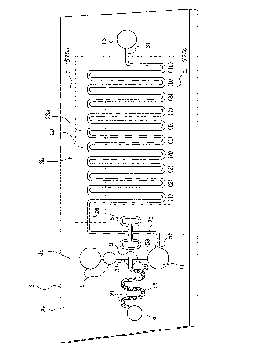 Abstract: Abstract:PROBLEM TO BE SOLVED: To provide a nucleic acid isolation member (chip) producible at a low cost, hardly causing stain of DNA, capable of decreasing the amount of a specimen to be purified, requiring little labor because employing a throughput type, and requiring short time for treatment, and to provide a method for producing the chip. SOLUTION: The chip comprises a main body 3 and a cover 4 covering the upper face of the main body 3. The main body 3 has, as a nucleic acid separator 3b, a holder 5, a nucleic acid isolator 15, a waste liquid holder 9, a holder 11, paths 27 and 29, and a valve 51. In the nucleic acid isolator 15, many columnar projects 21 are formed and silica elements 39 are exposed on the surface of the projects. The chip has, as an amplifying part 3c, a path 25, a mixer 57, a guide path 26, a valve 55, a PCR amplifier 23, a path 31, and a holder 13. A biomaterial is fed from the holder 5 to the nucleic acid isolator 15 and DNA in the biomaterial is adsorbed on the projects 21. The adsorbed DNA is eluted with a reagent and amplified by the PCR amplifier 23. |
SILANE COUPLING AGENT
| (11)Publication number : | 2005-225789 |
| (43)Date of publication of application : | 25.08.2005 |
| (51)Int.CI. | C07F 7/18 |
| (21)Application number : | 2004-034819 | (71)Applicant : | UNIV KANAGAWA NIKON CORP |
| (22)Date of filing : | 12.02.2004 | (72)Inventor : | YAMAGUCHI KAZUO SHIONO HIROBUMI |
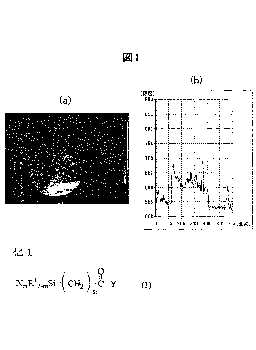 Abstract: Abstract:PROBLEM TO BE SOLVED: To provide a technique of efficiently immobilizing a biomaterial (e.g., a nucleic acid) on an inorganic material. SOLUTION: The silane coupling agent is represented by formula (1) (wherein X is an alkoxyl group or a halogen atom; R1 is an optionally substituted alkyl, alkenyl, or alkynyl group; m is an integer of 1 to 3; n is an integer of 2 to 20; and Y is an active ester residue such as an N-hydroxysulfosuccinimide ester residue). A method for silanizing an inorganic material by using the same is provided. A method for immobilizing an amino compound on the silanized inorganic material is also provided. |
NEW POLYPEPTIDE AND METHOD FOR PRODUCING THE SAME
| (11)Publication number : | 2005-206542 |
| (43)Date of publication of application : | 04.08.2005 |
| (51)Int.CI. |
C07K 14/00 C07K 1/10 C07K 17/14 |
| (21)Application number : | 2004-016031 | (71)Applicant : | TANIHARA MASAO |
| (22)Date of filing : | 23.01.2004 | (72)Inventor : | TANIHARA MASAO |
| Abstract: PROBLEM TO BE SOLVED: To provide a new polypeptide hardly providing risk of infection with pathogen and unpleasant side effects, and useful as a highly safe biomaterial or biocompatible material, for example, useful for a supplying, restoring or regenerating biological hard tissue. SOLUTION: The new polypeptide contains a peptide unit having an amino acid sequence represented by the formula (1): -Pro-X-Gly- (1) and a peptide unit having an amino acid sequence represented by the formula (2): -Y-Z-Gly- (2) [in the formulas, X and Z are the same or different and each Pro or Hyp; Y is an amino acid residue having a carboxy group (such as Asp, Glu and Gla)]. The ratio [molar ratio (1)/(2)] of the peptide unit (1) to the peptide unit (2) is about (99/1) to (1/99). The peptide may support apatites. |
MATERIAL MACHINING METHOD BY MULTI-WAVELENGTH ULTRASHORT PULSE LASER BEAM
| (11)Publication number : | 2005-205446 |
| (43)Date of publication of application : | 04.08.2005 |
| (51)Int.CI. |
B23K 26/06 G02F 1/37 G02F 1/39 |
| (21)Application number : | 2004-014126 | (71)Applicant : | TECH RES & DEV INST OF JAPAN DEF AGENCY |
| (22)Date of filing : | 22.01.2004 | (72)Inventor : | OGOSHI MASAYUKI INOUE SHIGEMI |
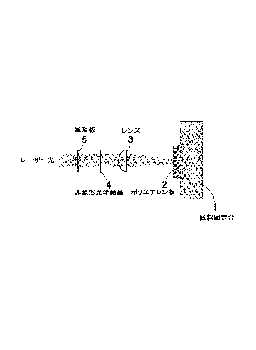 Abstract: Abstract:PROBLEM TO BE SOLVED: To establish a highly accurate and high speed fine machining method for material by which, even in material having no resistance to heat (such as a high polymer material, a biomaterial, a low melting point material and a material easy to be thermally diffused), a thermally modified layer is not formed around the machined part and the chemical composition of the machined face is not changed. SOLUTION: In the material machining method, the wavelength of a part of ultrashort pulse laser beams with a pulse width of <1 ns including near infrared rays is converted by a nonlinear optical crystal 4, an optical parametric amplifier or the like, and the same part in the same material is irradiated with harmonics (one or more kinds of laser beams whose wavelength has been converted to be short) or the beams of an OPA or the like (one or more kinds of laser beams whose wavelength has been converted to be long ) together with fundamental waves (laser beams before the conversion of the wavelength), thus highly accurate and high speed laser beam machining is made possible. |
PRETREATMENT METHOD AND APPLICATION OF BIOMATERIAL
| (11)Publication number : | 2005-160596 |
| (43)Date of publication of application : | 23.06.2005 |
| (51)Int.CI. |
A61L 27/00 // C12N 5/06 |
| (21)Application number : | 2003-400924 | (71)Applicant : | NATIONAL INSTITUTE OF ADVANCED INDUSTRIAL & TECHNOLOGY ISHIGURO NAOKI SUGIURA FUMIAKI |
| (22)Date of filing : | 28.11.2003 | (72)Inventor : | TERAOKA HIROSHI ISHIGURO NAOKI SUGIURA FUMIAKI |
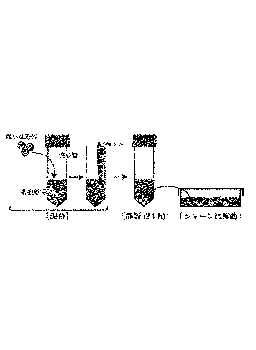 Abstract: Abstract:PROBLEM TO BE SOLVED: To provide a new pretreatment method and application of biomaterial contributing to regeneration medical treatment and cell medical treatment. SOLUTION: A method for preparing an artificial bone unit containing cells pretreated so as to be able to be applied to a living body by agitatably mixing micromoldings into the suspension liquid of cells capable of expressing a hard tissue forming relating function is characterized of (1)preparing a cell suspension liquid of a predetermined cell concentration using the cells, (2)mixing a plurality of micromoldings into the cell suspension liquid to make the micromoldings trap the cells within the suspension liquid, (3)stationarily placing the micromoldings trapping the cells in a culturing environment or a cell differentiation environment, (4)forming micromoldings or cell complex bodies by culturing until a part or whole of the cells trapped by the micromoldings forms cell aggregated masses, and (5)preparing the artificial bone unit containing the cells capable of being applied in the living body by the above (1) to (4). And the artificial bone unit containing the cells is also disclosed. |
IMPROVED METHOD IN EXTRACTION AND PURIFICATION OF PROTEIN FROM BIOMATERIAL
| (11)Publication number : | 2005-154330 |
| (43)Date of publication of application : | 16.06.2005 |
| (51)Int.CI. |
C07K 14/415 C07K 1/14 |
| (21)Application number : | 2003-394064 | (71)Applicant : | HIRAOKA ATSUSHI |
| (22)Date of filing : | 25.11.2003 | (72)Inventor : | HIRAOKA ATSUSHI |
| Abstract: PROBLEM TO BE SOLVED: To provide an improved method in extraction and purification of a protein with an aqueous solution from a biomaterial containing o-diphenol, including a harvested plant and a recombinant plant. SOLUTION: The method is carried out by adding a material selected from the group consisting of (a) a water-soluble salt of a benzenesulfinic acid derivative, (b) oxalic acid or a water-soluble salt of the oxalic acid, and (c) a mixture of the water-soluble salt of one or more kinds of the material selected from the benzenesulfinic acid and the derivative thereof, with the oxalic acid or the water-soluble salt of the oxalic acid, to the aqueous solution. The derivative is obtained by substituting the benzene ring with a lower alkyl, an amino or a lower alkoxy group. As a result, the formation of an orthoquinone is prevented by the oxalic acid or the water-soluble salt of the oxalic acid, and the formed orthoquinone is converted into a stable derivative by the water-soluble salt of the benzenesulfinic acid derivative, to reduce the polymerization, to prevent the bonding of a polymer complex with an amino acid residue of the protein, to reduce impurities in the protein, to prevent interference and to improve the yield of the protein. |
BIOMATERIAL FOR ARTIFICIAL CARTILAGE
| (11)Publication number : | 2005-143800 |
| (43)Date of publication of application : | 09.06.2005 |
| (51)Int.CI. |
A61F 2/44 A61L 27/00 |
| (21)Application number : | 2003-385022 | (71)Applicant : | TAKIRON CO LTD |
| (22)Date of filing : | 14.11.2003 | (72)Inventor : | SHIKINAMI YASUO |
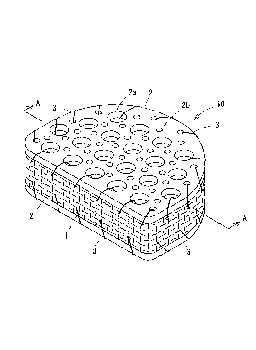 Abstract: Abstract:PROBLEM TO BE SOLVED: To provide a biomimetic biomaterial for an artificial cartilage which promotes connecting and fixing power to an animate bone such as a centrum or the like and prevents fine powder to occur by friction. SOLUTION: The biomaterial 10 for the artificial cartilage is made of layers of plates 2 with many penetration holes 2a and 2b perforated in a direction of the thickness and the plate 2 is made of a polymer with in-vivo decomposition absorbability which includes bioceramic powder with bioactivity at one side or both sides of a core material 1 which comprises an organic fiber composition structure of a multi-axis three dimensional woven composition or knitted composition with three or more axes or complex composition of the above. Since the core material 1 made of the organic fiber composition structure has almost same mechanical strength and flexibility of the cartilage, the biomaterial shows biomimetic deformation to function as the artificial cartilage sufficiently. The decomposition rate of the plate 2 which comprises the polymer with in-vivo decomposition absorbability is substantially balanced with the the growth rate of the bone tissue so that the plate is replaced by the bone tissue to connect firmly to the animate bone. |
METHOD FOR EXTRACTING RNA, AND METHOD FOR ANALYZING BIOMATERIAL
| (11)Publication number : | 2005-137295 |
| (43)Date of publication of application : | 02.06.2005 |
| (51)Int.CI. |
C12N 15/09 C12Q 1/68 |
| (21)Application number : | 2003-378516 | (71)Applicant : | HITACHI HIGH-TECHNOLOGIES CORP |
| (22)Date of filing : | 07.11.2003 | (72)Inventor : | YAMASHITA YOSHIHIRO SAKURAI TOMOYA KUNO NORITO UCHIDA NORITAKA YOKOBAYASHI TOSHIAKI |
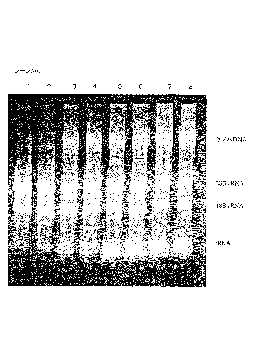 Abstract: Abstract:PROBLEM TO BE SOLVED: To provide a method for extracting a highly pure RNA from a biomaterial containing the RNA by a safe, rapid and ready operation, and analyzing the RNA. SOLUTION: The method for analyzing the RNA comprises adding a chaotropic agent in a prescribed concentration and an organic solvent in a prescribed concentration to the biomaterial containing the RNA, mixing the resultant mixture to provide a mixed solution, bringing the mixed solution into contact with a nucleic acid-binding solid, washing the nucleic acid-binding solid having the RNA bound thereto, and eluting the RNA from the nucleic acid-binding solid having the RNA bound thereto. The method also involves analyzing the obtained RNA by a reverse transcription polymerase chain reaction (RT-PCR) or the like. |
BIOMATERIAL
| (11)Publication number : | 2005-124996 |
| (43)Date of publication of application : | 19.05.2005 |
| (51)Int.CI. |
A61L 27/00 A61F 2/04 A61F 2/06 |
| (21)Application number : | 2003-366452 | (71)Applicant : | CELAGIX:KK NIKAIDO TOSHIO |
| (22)Date of filing : | 27.10.2003 | (72)Inventor : | NIKAIDO TOSHIO AMANO JUN KUBO KEISHI IWAMA MASAMICHI ISHIHARA YOSHIHISA |
| Abstract: PROBLEM TO BE SOLVED: To provide a new biomaterial which promotes tissue formation and suppresses stenosis due to the hyperplasia of connective tissue. SOLUTION: The biomaterial consists of: an amnion or amniotic cells; and a porous support body. It is preferable that the porous support body is reinforced by a reinforcing body. The reinforcing body may be of a ring shape or a spiral shape. The material for the porous support body is preferably segmented polyurethane, more preferably, aliphatic segmented polyurethane. It is preferable that the amnion or the amniotic cells to be used is the amnion or the amniotic cells originating from a human. |
BIOMATERIAL AND ITS MANUFACTURING METHOD THEREOF
| (11)Publication number : | 2005-124709 |
| (43)Date of publication of application : | 19.05.2005 |
| (51)Int.CI. | A61L 27/00 |
| (21)Application number : | 2003-361783 | (71)Applicant : | OLYMPUS CORP |
| (22)Date of filing : | 22.10.2003 | (72)Inventor : | HAKAMAZUKA KOJI SADAMORI KATSUYA KUROSAKA MASAHIRO |
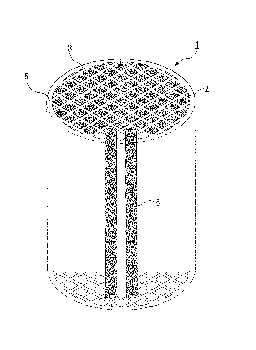 Abstract: Abstract:PROBLEM TO BE SOLVED: To provide a biomaterial and a manufacturing method thereof capable of improving cell adhesion, ensuring a necessary strength for a region to be transplanted, and relieving strain on a patient. SOLUTION: This bone replacement material (biomaterial) 1 is a scaffold material composed of porous calcium phosphate (for example, β-TCP) material, which includes a honeycomb-shaped main body 5 having a plurality of piercing holes 2 obtained by mutually partitioned by a partition 3 of about the same thickness. The piercing hole 2 is provided so as to be stuffed with a powder material (porous member) 6 containing calcium phosphate (for example, β-TCP). |
CERAMIC SINTERED COMPACT, METHOD FOR PRODUCING THE SAME, AND BIOMATERIAL
| (11)Publication number : | 2005-075659 |
| (43)Date of publication of application : | 24.03.2005 |
| (51)Int.CI. |
C04B 35/10 A61L 27/00 |
| (21)Application number : | 2003-305233 | (71)Applicant : | KYOCERA CORP |
| (22)Date of filing : | 28.08.2003 | (72)Inventor : | OU USOU SENO HIROAKI YOMO KUNIHIDE ONIZUKA SHUGO |
| Abstract: PROBLEM TO BE SOLVED: To provide a high hardness and high strength ceramic sintered compact. SOLUTION: The ceramic sintered compact is the one comprising Al2O3, ZrO2, SiO2, TiO2, and MgO, wherein the Al2O3 content is 65 to 96 mass%, the Zr2O2 content is 4 to 34.4 mass%, the SiO2 content is 0.20 mass% or higher, the TiO2 content is 0.22 mass% or higher, the MgO content is 0.12 mass% or higher, and the total content of SiO2, TiO2, and MgO is 0.6 to 4.5 mass%. |
COMPOSITE OSTEOSYNTHESIS MATERIAL
| (11)Publication number : | 2005-066354 |
| (43)Date of publication of application : | 17.03.2005 |
| (51)Int.CI. A61L 27/00 C08K 3/32 C08L 67/04 // A61F 2/28 A61F 2/30 |
| (21)Application number : | 2004-290055 | (71)Applicant : | TAKIRON CO LTD |
| (22)Date of filing : | 01.10.2004 | (72)Inventor : | SHIKINAMI YASUO OKUNO MASAKI |
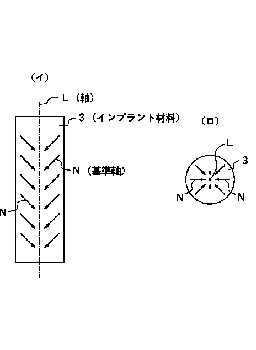 Abstract: Abstract:PROBLEM TO BE SOLVED: To provide a more ideal biomaterial which has decomposition absorbability in the living body, can be replaced by the living body, and is concurrently useful for application such as an artificial bone, an artificial joint, an artificial dental root, a bone filling material, an osteosynthesis material, and a bone prosthetic material which are equipped with association with the living body and the inductivity of tissue, and are bioactive, new and useful. SOLUTION: (1) A bioresorbable bio-ceramic powder of 10-60 wt.% of 0.2-50 μm diameter is dispersed evenly in a biodegradable absorbable crystalline thermoplastic polymer matrix. A composite implant material consists of a high-density oriented shaped article which has a degree of crystallinity of 10-70%. (2) A compound material described in (1) is oriented by the crystallized matrix polymer under pressure and consists of the high-strength pressurized oriented shaped article which has a degree of crystallinity of 10-70%. |
POROUS STRUCTURE
| (11)Publication number : | 2005-061961 |
| (43)Date of publication of application : | 10.03.2005 |
| (51)Int.CI. G01N 27/327 B81B 1/00 B82B 1/00 C12M 1/00 C12M 1/34 C12N 15/09 G01N 27/416 |
| (21)Application number : | 2003-291531 | (71)Applicant : | CANON INC |
| (22)Date of filing : | 11.08.2003 | (72)Inventor : | SHIOZUKA HIDENORI IMAMURA TAKESHI FUKUTANI KAZUHIKO DEN TORU OGAWA YOSHINORI MIYATA HIROKATSU |
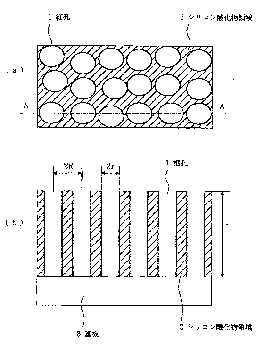 Abstract: Abstract:PROBLEM TO BE SOLVED: To provide a porous structure having a novel configuration which expands its application to various kinds of devices which are complexes of an inorganic material and a biomaterial. SOLUTION: The porous structure, of which the pores carry a functional material, contains two or more components forming eutectic crystals and has a plurality of columnar pores, wherein a biopolymer as the functional material is carried by the wall surface of the pores. The biopolymer is either a protein, a nucleic acid, or a protein and a nucleic acid. The structure contains silicon or aluminum. |
ARTIFICIAL BIOMATERIAL AND ITS PRODUCTION METHOD
| (11)Publication number : | 2005-013261 |
| (43)Date of publication of application : | 20.01.2005 |
| (51)Int.CI. A61L 27/00 A61C 5/00 A61C 8/00 A61F 2/28 A61F 2/30 A61K 6/04 // C22C 14/00 |
| (21)Application number : | 2003-178162 | (71)Applicant : | YAMASHITA KIKUJI NISSAN CHEM IND LTD |
| (22)Date of filing : | 23.06.2003 | (72)Inventor : | YAMASHITA KIKUJI IWAMA TAKEHISA |
| Abstract: PROBLEM TO BE SOLVED: To provide an artificial biomaterial with deposited colloidal silica particles which is embedded in a living body and useful as an artificial biomaterial (an implant material) for an artificial bone, an artificial joint and an artificial dental root, and its production method. SOLUTION: The artificial biomaterial is formed to deposit the colloidal silica particles on the surface of the material, and the production method of the above artificial biomaterial is to bring the above material into contact with suspension of the colloidal silica particles and to dry the same with a temperature of 1-115°C. |
